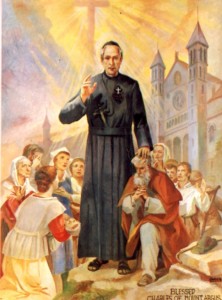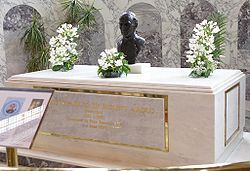
St Charles of Mt. Argus, Dublin, Priest, Religious. Charles John Houben (1821-1893), was a Dutch Passionist priest who served in Dublin in the late 19th-century. He showed extraordinary compassion for the sick and those in need of guidance. Many came asking his prayers, and in latter life his reputation for healings was such that a reference is made to him by James Joyce in Ulysses. He was canonized in 2007 and his feast day is today
 Charles was renowned for his gifts of bodily and spiritual healing during his many years of service at the Passionist Church at Harold’s Cross, Dublin. A man healed of a seemingly terminal illness through his intercession attended his canonisation inRome on the 3rd June 2007.
Charles was renowned for his gifts of bodily and spiritual healing during his many years of service at the Passionist Church at Harold’s Cross, Dublin. A man healed of a seemingly terminal illness through his intercession attended his canonisation inRome on the 3rd June 2007.
Patrick Duffy tells the story.
Childhood
St Charles was born Joannes Andreas Houben on 11 December 1821 in the village of Munstergeleen ,a village in the south-east of Holland near the border with Germany and Belgium. in the Province of Limburg in the United Kingdom of the Netherlands. His parents were Peter Joseph Houben and his wife, Johanna Elizabeth Luyten. His father was a miller by trade. As a boy Andrew attended the village primary school. he was he fourth of 11 children in a poor family. To those outside his family he seemed quiet and extremely shy. John Andrew was a shy but cheerful boy who like singing to himself around the house. He liked serving Mass and visiting the church during the day. A slow learner, for ten years he walked the two miles to a secondary school at nearby town of Sittard. Neighbours began to wonder if he would ever finish school.
He joined the army as a reserve in 1840, but as he wasn’t very good at being a soldier, he only spent three months on active service. While in the army he heard of the Passionists and decided he wanted to become a Passionist priest. This meant he had to resume studying.
Vocation
John returned to work at his uncle’s mill by day and studied in his spare time. When he got his official discharge from the army in 1845, he went to join the Passionist novitiate at Ere in Belgium and was given the name Charles. By now his mother and uncle had both died and though his father tried to dissuade him, John Andrew had made up his mind. Houben was admitted to the novitiate of the Passionists, who had recently arrived in Belgium, in the village of Ere, near Tournai. He professed his religious vows the following year and was given the religious habit and the religious name of Charles of St. Andrew.

Fr Charles wearing the Passionist habit (1851)
Ordination
He was good-humoured and cheerful as a novice and student. When his ordination day came on 21st December 1850, his father had died and, because of the huge expense of his father’s long illness and funeral, none of his family was able to make the journey to attend his ordination at Tournai in Belgium.
First assignment in England
In February 1852 he was assigned to England. Here he came in contact with the many Irish who, unable to go to America, had gone to England because of the Famine. Fr Charles’s heart went out to them. He admired their struggle and their loyalty to the faith. Even then, he began to call them “my people”.
At Mount Argus, Dublin
Five years later, aged 35, he arrived at the newly founded monastery of Mount Argus at Harold’s Cross, Dublin. At that time there were ten Passionists living in a reconstructed farmhouse with a temporary chapel added. But soon they started building an eighty-roomed monastery and retreat house for priests and lay people, the first of its kind in Ireland. Charles helped to fund-raise for the new monastery and retreat house all over Ireland and was quite successful at it.
A popular confessor
Charles wasn’t a great preacher, never really mastering the language, but his gift was in the confessional and comforting the sick. In community he was cheerful and often was heard humming the Dutch National Anthem as he walked around the house.
 A reputation for healing
A reputation for healing
It became a daily routine for him to walk from the monastery to the Church preaching to the kneeling people about the love Jesus showed in his passion. Inside the church he would pray privately, ask the people to renew their baptismal promises, bless them with the relic of St. Paul of the Cross, and then move among them laying his hands on them in prayer. Great graces were attributed to his prayers – not only physical cures but also healing of depressions and psychological disorders. Often people would send carriages to bring him out through the city and into the country to visit the sick at a distance.
Allegations
But trouble was brewing for the priest with the gift of healing. Some doctors complained to Cardinal Cullen and wrote to the newspapers alleging that Charles was telling sick people they had no need to go to a doctor. Also his custom of blessing holy water with a relic of St Paul of the Cross for people to take home with them led some traders to cash in on the act – bottling the water and offering it for sale countrywide. This led to allegations of simony. Although Charles was innocent of both charges, an agreement was reached between Cardinal Cullen and his superiors to send him back to England as the only way to stop the scandal. He remained there for eight years (1866-74) helping with novices and working in various parishes. But there is no evidence that any unusual cures occurred there.
Return to Ireland and death
When the dust settled, Charles was able to return to Mount Argus and live there for the last nineteen years of his life. The crowds came and the cures began again. But an accident – a trap in which he was travelling overturned near St Clare’s Convent at Harold’s Cross – caused both a fracture which never set right and a wound which became ulcerated. Also he had constant toothache; he didn’t complain, but people saw his swollen jaw and his hand going up to his mouth. Gradually he grew too weak to say Mass and he died peacefully on 5th January 1893. It was said he had a bigger funeral than Parnell who died in 1891. The Superior of the monastery wrote to his family: “The people have already declared him a saint
A place of pilgrimage
 Fr Charles’s grave in the community cemetery soon became a place of pilgrimage. But people sometimes took away pieces of clay. In 1949 his body was transferred to a shrine inside the church. He was declared Venerable by Pope John Paul II in 1979.
Fr Charles’s grave in the community cemetery soon became a place of pilgrimage. But people sometimes took away pieces of clay. In 1949 his body was transferred to a shrine inside the church. He was declared Venerable by Pope John Paul II in 1979.
Miracles of healing
The cure of a Dutch woman, Mrs Verhegge, with a large inoperable growth in her stomach, opened the way for his beatification in 1988 by Pope John Paul II. A second miracle took place in Charles’ home village of Munstergeleen in 1999. JHA Dormans experienced abdominal pains that turned out to be a ruptured appendix. From the beginning of his illness Mr Dormans entrusted himself in faith into the hands of Blessed Charles. Surgery exposed porous intestines and every effort to stem the leaks only seemed to make matters worse. The surgeon explained to the family he had reached the limits of what he could do. Mr Dormans received the last sacraments and the family said their good-byes. They invoked Blessed Charles to guide him through the difficult hours. But he did not die. Doctors could not believe it when he began to recover. Subsequent surgery revealed that the intestines had healed naturally; only a small suture was needed to complete the process. Mr Dormans was present at the canonisation of the saint who healed him.
As Archbishop of Dublin, Archbishop Diarmuid Martin was what is called the Actor in the cause of Blessed Charles. He and many Passionists along with many lay people attended the canonisation in St Peter’s Rome by Pope Benedict XVI on Sunday 3rd June 2007.
Prayer for the intercession of Blessed Charles
Heavenly Father,
you filled Blessed Charles with your Holy Spirit.In love with Christ Crucified
he spent his life in prayer at the foot of the cross.
From the cross he went forth to bring good news to the poor,
healing to the sick and dying,
and forgiveness to the sinner.Through the intercession of Blessed Charles
give us the graces we need.
Heal our aches and pains,
our hurts and wounds,
our anxieties and bad memories.
Free us from depressions, habits of sin, ald all evil.
Strengthen our faith,
deepen our hope,
and increase our love.We make our prayer through Christ our Lord.
Our Father, Hail Mary, Glory be to the Father.
Blessed Charles, pray for us.